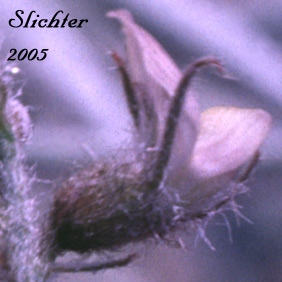 The
photo at right shows a close-up of the flower of Lyall's milk-vetch as seen along
the Columbia River about one mile north of the Vernita Bridge across the Columbia
River in central Washington.........April 20, 2002. Note the distinctly reflexed
banner and the long, linear, almost spidery calyx lobes.
The
photo at right shows a close-up of the flower of Lyall's milk-vetch as seen along
the Columbia River about one mile north of the Vernita Bridge across the Columbia
River in central Washington.........April 20, 2002. Note the distinctly reflexed
banner and the long, linear, almost spidery calyx lobes.
Lyall's milk-vetch is an erect perennial wildflower with several thin, branched stems clustered on a short, woody base and rising 10-20 cm high. The leaves and stems are variously pubescent, with grayish hairs that are soft, silky and appressed, stiff, sharp and appressed, or woolly and spreading. The ascending, pinnately compound leaves are 3-11.5 cm long with 11-21 leaflets that are lance-linear, linear-elliptic, or narrowly oblong in shape with acute, obtuse (lower leaflets) or rounded tips. The leaflets range from 8-15 mm long.
The loosely flowered racemes are axils and about equal to or longer than the upper leaves. The stout pedicels are 1 mm long while the woolly, bell-shaped calyx measures 5 mm long with linear teeth that are up to twice as long as the calyx tube. The whitish to pale lavender corolla is 6-8 mm long with purple-lined wings and banner. The narrow banner is well-reflexed and measures 4.5-7.5 mm long. The pod is lance-oblong in outline, slightly compressed, and 6-7 mm long and somewhat heart-shaped in cross-section. The pods are somewhat glabrous to woolly-haired.
variety caricinus: Lower stipules clasping or joined with a fringed margin while the upper ones are triangular and not joined. Pods 6-8.5 mm long and 2-3 mm wide. Raceme shorter, flowering only from the upper 2-5 nodes.
variety lyallii: All stipules triangular, not joined. Pods 5-8 mm long and 2-3.5 mm wide. Raceme longer, flowering from the upper half of the stem.
Lyall's milk-vetch is found on sandy slopes and among sagebrush in the basin valleys and on low hillsides.
Lyall's milk-vetch is found from Kittitas County in central Washington south along the Yakima and Columbia Rivers to south-central Washington and upstream along the Snake River to southeastern Idaho and northeastern Malheur County in eastern Oregon.